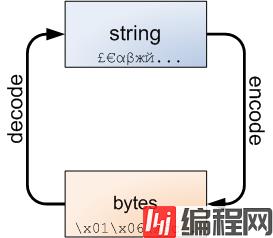Python 官方文档:入门教程 => 点击学习
python3 中 str 与 bytes 的转换:The bytes/str dichotomy in python 3字符与 Unicode 编号之间的转换# 字符转 Unicode 编号 >>> ord('

字符与 Unicode 编号之间的转换
# 字符转 Unicode 编号
>>> ord('A')
65
>>> hex(ord('A'))
'0x41'
>>> ord('你')
20320
>>> hex(ord('你'))
'0x4f60'
>>> '你好'.encode('unicode_escape')
b'\\u4f60\\u597d'
# Unicode 编号转字符
>>> chr(65)
'A'
>>> chr(0x41)
'A'
>>> chr(20320)
'你'
>>> chr(0x4f60)
'你'
>>> b'\\u4f60\\u597d'.decode(('unicode_escape'))
'你好'
>>> print(b'\\u4f60\\u597d')
b'\\u4f60\\u597d'
>>> print(u'\u4f60\u597d')
你好汉字与 gbk 十六进制(二进制)之间的转换。
# 汉字转十六进制
>>> '你好'.encode('gbk')
b'\xc4\xe3\xba\xc3'
# 十六进制转汉字
>>> b'\xc4\xe3\xba\xc3'.decode('gbk')
'你好'
# 汉字转十六进制字符串
>>> ''.join( [ '%02X' % x for x in '你好'.encode('gbk') ] ).strip()
'C4E3BAC3'
>>> ' '.join( [ '%02X' % x for x in '你好'.encode('gbk') ] ).strip()
'C4 E3 BA C3'
# 十六进制字符串转汉字
>>> bytes.fromhex('C4E3BAC3').decode('gbk')
'你好'
>>> bytes.fromhex('C4 E3 BA C3').decode('gbk')
'你好'数字与十六进制(二进制)之间的转换
# 数字转十六进制字符串
>>> hex(21)
'0x15'
>>> hex(21)[2:]
'15'
# 十六进制字符串转数字
>>> int('0x15', 16)
21
>>> int('15', 16)
21
# 数字转八进制字符串
>>> oct(21)
'0o25'
>>> oct(21)[2:]
'25'
# 八进制字符串转数字
>>> int('0o25', 8)
21
>>> int('25', 8)
21
# 数字转二进制字符串
>>> bin(5)
'0b101'
>>> bin(5)[2:]
'101'
# 二进制字符串转数字
>>> int('0b101', 2)
5
>>> int('101', 2)
5bytes 相关
# bytes 对象转十六进制字符串
>>> "%02X" % ord(b'\xff')
'FF'
>>> ''.join(["%02X" % i for i in b'\xe4\xbd\xa0\xe5\xa5\xbd'])
'E4BDA0E5A5BD'
# bytes 转 int
>>> ord(b'\xff')
255
# int 转 bytes
>>> bytes([255])
b'\xff'bit 相关(需使用第三方包 bitarray)
# 字符串转 01 串(默认 endian 是大端)
>>> arr = bitarray()
>>> arr.frombytes('你好'.encode('utf8'))
>>> arr.to01()
'111001001011110110100000111001011010010110111101'
# 01 串转字符串
>>> bitarray('111001001011110110100000111001011010010110111101').tobytes().decode('utf8')
'你好'关于utf8的bom头。(Python3下)
>>> import codecs
>>> codecs.BOM_UTF8
b'\xef\xbb\xbf'
>>> len(b'\xef\xbb\xbf')
3
>>> codecs.BOM_UTF8.decode('utf8')
'\ufeff'
>>> len('\ufeff')
1Python3 有哪些编码:Standard Encodings、Python Specific Encodings 。
打印编码及别名。(Get a list of all the encodings Python can encode to)
>>> from encodings.aliases import aliases
>>> for k in aliases:
print('%s: %s' % (k, aliases[k]))验证是不是有效编码。
>>> import codecs
>>> codecs.lookup('utf8') #有效
<codecs.CodecInfo object for encoding utf-8 at 0x13fb4f50828>
>>> codecs.lookup('utf-;8') #有效
<codecs.CodecInfo object for encoding utf-8 at 0x13fb4f50a08>
>>> codecs.lookup('utf88') #无效
Traceback (most recent call last):
File "<pyshell#4>", line 1, in <module>
codecs.lookup('utf88')
LookupError: unknown encoding: utf88标准化 encoding。
>>> import encodings
>>> encodings.nORMalize_encoding('utf-;8')
'utf_8'对应 C 代码为:unicodeobject.c 中的 _Py_normalize_encoding 函数。
sys/locale 模块中与编码相关的方法。(Python字符编码详解)
import sys
import locale
# 当前系统所使用的默认字符编码
>>> sys.getdefaultencoding()
'utf-8'
# 用于转换 Unicode 文件名至系统文件名所使用的编码
>>> sys.getfilesystemencoding()
'utf-8'
# 获取默认的区域设置并返回元组(语言, 编码)
>>> locale.getdefaultlocale()
('zh_CN', 'cp936')
# 返回用户设定的文本数据编码
# 文档提到this function only returns a guess
>>> locale.getpreferredencoding()
'cp936'字符串反转
>>> line = '0123456789'
>>> line[::-1]
'9876543210'【相关阅读】
Unicode Tips
Python3 处理 gb18030 乱码
*** walker ***
--结束END--
本文标题: 关于 Python3 的编码
本文链接: https://lsjlt.com/news/193044.html(转载时请注明来源链接)
有问题或投稿请发送至: 邮箱/279061341@qq.com QQ/279061341
2024-03-01
2024-03-01
2024-03-01
2024-02-29
2024-02-29
2024-02-29
2024-02-29
2024-02-29
2024-02-29
2024-02-29
回答
回答
回答
回答
回答
回答
回答
回答
回答
回答
0